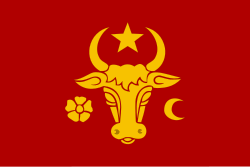Moldavia
Moldavia (Romanian: Moldova, pronounced [molˈdova] (![]() listen) or Țara Moldovei, literally "The Country of Moldavia"; in Romanian Cyrillic: Молдова or Цара Мѡлдовєй; Church Slavonic: Землѧ Молдавскаѧ; Greek: Ἡγεμονία τῆς Μολδαβίας) is a historical region and old principality in Central and Eastern Europe.[8][9][10] It is the territory between the Eastern Carpathians and the river Dniester. It used to be an independent state. It existed from the 14th century to 1859, when it united with Wallachia (Țara Românească) as the beginning of modern Romania. Sometimes the regions of Bessarabia (with Budjak), all of Bukovina and Hertsa were part of Moldavia. The region of Pokuttya was also part of it for some time.
listen) or Țara Moldovei, literally "The Country of Moldavia"; in Romanian Cyrillic: Молдова or Цара Мѡлдовєй; Church Slavonic: Землѧ Молдавскаѧ; Greek: Ἡγεμονία τῆς Μολδαβίας) is a historical region and old principality in Central and Eastern Europe.[8][9][10] It is the territory between the Eastern Carpathians and the river Dniester. It used to be an independent state. It existed from the 14th century to 1859, when it united with Wallachia (Țara Românească) as the beginning of modern Romania. Sometimes the regions of Bessarabia (with Budjak), all of Bukovina and Hertsa were part of Moldavia. The region of Pokuttya was also part of it for some time.
Principality of Moldavia | |||||||||||||||
|---|---|---|---|---|---|---|---|---|---|---|---|---|---|---|---|
| 1346–1859 | |||||||||||||||
 Location of the Principality of Moldavia, 1789 | |||||||||||||||
 Moldavia under Stephen the Great, 1483 | |||||||||||||||
| Status |
| ||||||||||||||
| Capital | Baia/Siret (1343–1388) Suceava (1388–1564) Iași (1564–1859) | ||||||||||||||
| Common languages | |||||||||||||||
| Religion | Eastern Orthodox | ||||||||||||||
| Demonym(s) | Moldavian | ||||||||||||||
| Government | Principality: elective absolute monarchy with hereditary lines | ||||||||||||||
| Princes of Moldavia (Voivodes, Hospodars) | |||||||||||||||
• 1346–1353 (first) | Dragoș | ||||||||||||||
• 1859–1862 (last) | Alexandru Ioan Cuza | ||||||||||||||
| History | |||||||||||||||
• | 1346 | ||||||||||||||
• | 5 February [O.S. 24 January] 1859 | ||||||||||||||
| Currency | Moldavian gros Taler | ||||||||||||||
| ISO 3166 code | MD | ||||||||||||||
| |||||||||||||||
| Today part of | |||||||||||||||
The western half of Moldavia is now part of Romania, the eastern part is in the Republic of Moldova, and the northern and southeastern parts are in Ukraine.
Moldavia Media
The hunt of Voivode Dragoș' for the bison (by Constantin Lecca)
Ruins of the Roman Catholic Cathedral established by Transylvanian Saxon colonists at Baia (German: Moldenmarkt), Suceava County, Romania
The Seat Fortress in Suceava, Romania
Equestrian statue of Moldavian Prince Stephen the Great in Suceava
Neamț Citadel in Târgu Neamț, Romania
Akkerman Fortress in Cetatea Alba, Ukraine
Notes
References
- ↑ 1.0 1.1 Moldavia at britannica.com
- ↑ 2.0 2.1 Protectorate at britannica.com
- ↑ Ștefan Pascu, Documente străine despre români, ed. Arhivelor statului, București 1992, ISBN 973-95711-2-3
- ↑ "Tout ce pays: la Wallachie, la Moldavie et la plus part de la Transylvanie, a esté peuplé des colonies romaines du temps de Trajan l'empereur... Ceux du pays se disent vrais successeurs des Romains et nomment leur parler romanechte, c'est-à-dire romain... " in Voyage fait par moy, Pierre Lescalopier l'an 1574 de Venise a Constantinople, in: Paul Cernovodeanu, Studii și materiale de istorie medievală, IV, 1960, p. 444
- ↑ Panaitescu, Petre P. (1965). Începuturile şi biruinţa scrisului în limba română (in română). Editura Academiei Bucureşti. p. 5.
- ↑ Kamusella, T. (2008). The Politics of Language and Nationalism in Modern Central Europe. Springer. p. 352. ISBN 9780230583474.
- ↑ Olson, James Stuart; Pappas, Lee Brigance; Pappas, Nicholas Charles; Pappas, Nicholas C. J. (1994). An Ethnohistorical Dictionary of the Russian and Soviet Empires. Greenwood Publishing Group. p. 550. ISBN 9780313274978.
- ↑ Janowski, Maciej; Constantin, Iordachi; Trencsenyi, Balazs (2005). "Why bother about historical regions?: Debates over central Europe in Hungary, Poland and Romania". East Central Europe. 32 (1–2): 5–58. doi:10.1163/18763308-90001031.
- ↑ Klaus Peter Berger (1 January 2010). The Creeping Codification of the New Lex Mercatoria. Kluwer Law International B.V. pp. 132–. ISBN 978-90-411-3179-9.
- ↑ Radu, Sageata (February 2015). "România – Ţară Central-Europeană". Revista Română de Geografie Politică. IV. 15-20. ISSN 2065-1619.
- Gheorghe I. Brătianu, Sfatul domnesc și Adunarea Stărilor în Principatele Române, Bucharest, 1995
- Vlad Georgescu, Istoria ideilor politice românești (1369-1878), Munich, 1987
- Ștefan Ștefănescu, Istoria medie a României, Bucharest, 1991
Other websites
- Dimitrie Cantemir-Descrierea Moldovei
- The Princely Court in Bacău - images, layouts (at the Romanian Group for an Alternative History Website)
- Original Documents concerning both Moldavia and other Romania Principalities during the Middle Ages (at the Romanian Group for an Alternative History Website)
- Pilgrimage and Cultural Heritage Tourism in Moldavia
- Painted Churches in Bukovina
- Medieval Coins of Moldavia and Wallachia (in Romanian and English)








